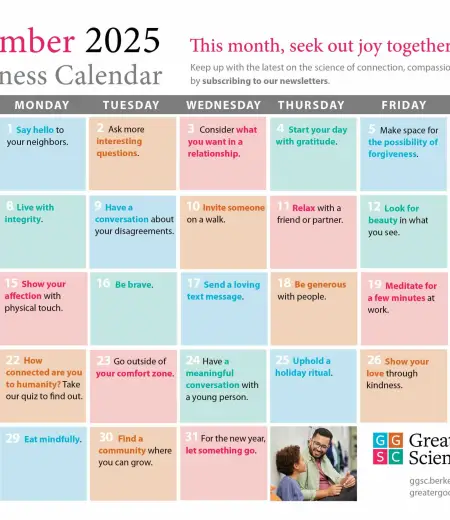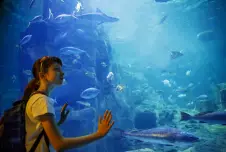Heidi Lawrence’s path to awe started more than a decade ago when she began working on ideas for her Ph.D. in English literature. Exploring Madeleine L’Engle’s A Wrinkle in Time and other adolescent novels, she began noticing patterns of connection between the characters’ inner worlds and their relationships with nature—specifically, the ways characters’ emotional worlds often mirror or are shaped by their relationships with the natural world.

“I’ve been kind of watching for those connections ever since,” Lawrence says.
Lawrence, an adjunct professor in the English department at Brigham Young University, teaches pre-service teachers. Her Ph.D. work left her with an intuitive sense that even a few minutes outdoors could shift something fundamental in her students.
She began guiding her students on “Wonder Walks”—15-minute outings to slow down and notice the world around them. Inspired by Time of Wonder by Robert McCloskey and Wonder Walkers by Micha Archer, Lawrence had included these walks in her children’s literature class for a few semesters. But it wasn’t until she took the Awe in Education course for educators offered by the Greater Good Science Center that everything clicked into place.
“When I got into the awe course, I thought, ‘Oh, awe walks? That’s interesting. It’s kind of similar to what I’ve been doing already,’” Lawrence says.
She encouraged her students to find a connection to nature by going outside, reflecting, and simply being present. At first, some resisted, seeing it as extra work. But once they settled into the stillness, the feedback was striking.
“I started getting responses like, ‘I’ve been really, really stressed this week, that 15 minutes gave me a chance to clear my head,’” Lawrence says. “‘It gave me a chance to just kind of calm down and relax, and then I was able to be refreshed going back into my work.’”
The science of awe
Awe is often experienced when we are in the presence of something that feels greater than ourselves. It transcends our understanding of what we have come to know about the world. From watching the sun rise, to hearing a song that brings you to tears, to visiting a religious structure, awe is a feeling that encompasses wonder, astonishment, and veneration.
Research finds that awe can reduce stress by lowering inflammation and reducing activation of the sympathetic nervous system. Additionally, it can foster kind and helpful behavior, leading to greater generosity, cooperation, and empathy.
When children learn how to actively experience and appreciate awe-inspiring moments, they begin to think beyond themselves, leading to enhanced cognitive flexibility and curiosity.
“Children are intrinsically curious explorers and hungry for new information,” write researcher Eftychia Stamkou and her colleagues. “Given their developing knowledge across domains, it is sound to assume that children will often encounter things that seem vast in relation to the self and transcend their previous knowledge—two critical ingredients of awe.”
For educators looking to shift toward awe-based education, incorporating moments of awe can transform school culture by fostering deeper engagement, creativity, and emotional resilience among students. When educators create moments of wonder and curiosity, it’s not just about knowledge, but about nurturing connection, well-being, and a sense of belonging in the classroom.
Awe in action
Lawrence’s students, future teachers themselves, began to recognize the value of these small, intentional pauses. They noticed the beauty of the night sky on cold winter nights, made unexpected connections between nature and storytelling, and reflected on how they might bring these experiences into their own classrooms. Some even felt a deep spiritual connection, a sense of belonging to something greater than themselves.
These moments of awe, Lawrence observed, didn’t just support mental clarity and creativity, they opened up new ways of perceiving the world.
“If they are open to the surprises and exciting aspects, even just the everyday aspects, of a different way of thinking . . . it could evoke awe, and that awe could evoke better understanding,” Lawrence says.
For Lawrence, awe is more than a concept; it’s a way of seeing the world. It’s about slowing down and inviting students into moments that transcend their daily routines. It’s also a tool that her future educators can use to foster resilience, curiosity, and connection in their classrooms for years to come.
Even when going outside isn’t possible, Lawrence encourages her students to cultivate awe indoors by growing plants, collecting leaves or acorns, or even watching nature videos.
“This isn’t something you have to stress over every day,” Lawrence says. “You can do 15 minutes once a week if that’s all that works for you, and you’ll start to see something happening.”
Incorporating awe in the classroom
Educator Emily Wilson Brenner has been teaching since 2002 and has worked in various locations, including the Northeast and Southeast U.S., and overseas in Casablanca, Morocco. She moved to San Francisco in 2019, soon before the pandemic, where she now teaches English and Theory of Knowledge, a course focused on epistemology and understanding how we know what we know, at an independent International Baccalaureate school.
 A flowering bush that Brenner's students encountered on their recent awe walks, a reminder of new possibilities.
A flowering bush that Brenner's students encountered on their recent awe walks, a reminder of new possibilities.
Wilson Brenner has always had an interest in psychology and became particularly interested in awe after reading researcher Dacher Keltner’s book Awe: The New Science of Everyday Wonder and How It Can Transform Your Life and participating in the Awe in Education course.
“I was teaching all day, every day, remotely on Zoom,” Wilson Brenner says. “But there was still something missing, and I really think that was connection and just that real humanity.”
Going back into the classroom post-pandemic, one of Wilson Brenner’s main goals was to help students notice details, be mindful of their surroundings, and express their authentic voices while experiencing and reflecting on moments of awe.
“Notice the sound of the birds in the park despite the whirl of the cars going by,” Wilson Brenner says. “Notice the details and notice the things that aren’t as obvious, the things that others aren’t noticing. And this is awe, but this is also intelligence. This is cognition, right?”
In addition to using journal prompts that encourage her students to reflect on their inner experiences and connect them to themes in literature, Wilson Brenner incorporates awe into her daily teaching by utilizing texts like Frankenstein and other works from the Romantic period that explore the sublime. In literature, the sublime is a theme that evokes awe and reminds us of our smallness, our aliveness, and our connection to something greater.
“There is the awe-some and the aw-ful, you know?” Wilson Brenner says. “When we’re looking at the terrible conflicts that we face as humans, how can we also explore the beauty that we experience as humans?”
Wilson Brenner recognizes that fostering awe in adolescents can be challenging since they often prioritize being indifferent and tend to be naturally skeptical. However, she sees this skepticism as a strength and believes that finding the right approach to engage them is essential.
So how can other educators bring awe into their classrooms? Wilson Brenner says the key is starting with connection, learning about students’ experiences and what moves them.
She not only minimizes technological distraction in her classroom to encourage a sense of community and connection, but she also asks her students about the languages they speak at home and what music they love at the beginning of the year. She then creates a class playlist based on their favorite songs, and plays it as they enter the room.
“When you’re looking at your curriculum, whatever the curriculum is, what are the places where this [awe] can exist?,” she says.
Here are a few practical ways educators can infuse awe into the classroom:
- Nature-based experiences: Outdoor learning, observing ecosystems, or watching a nature documentary are all options.
- Storytelling and literature: Explore myths, legends, and personal narratives that expand worldviews.
- Movies and music: Watch a film or listen to music that gives you that “wow” feeling. Something epic, beautiful, or just deeply moving.
- Classroom rituals: Small awe-inspiring practices, such as “awe journals,” reflective discussions, or sharing ideas.
- Create a playlist: Explore how shared music experiences create a sense of wonder and deepen connections with yourself and others.
- Collective acts of kindness: Recognize how collective generosity creates a sense of wonder and deeper connection with others.








Comments